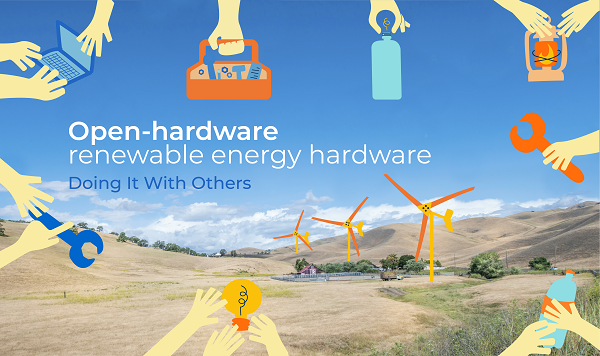Doing It With Others
Open-hardware renewable energy hardware
10 de Mayo de 2024

Open-source hardware presents a significant opportunity; however, when we start mapping-out solutions, we often lack a clear view of what we will find and what their potential might be. Sometimes, the first step is to follow the trails blazed by others so that, through different strategies and with a bit of perseverance, solutions begin to emerge. When it comes to renewable energies, one significant trail we found was the availability of self-construction kits or manuals, allowing anyone to build technologies through simple steps and with basic materials, aligning with the “Do it Yourself” (DIY) Movement.
This Maker Movement is characterized by the sharing of knowledge and collaborative work, enabling individuals—regardless of their location or their socioeconomic status—to use their designs, improve upon them, adapt them to their needs, or envisioning new functionalities. Beyond being an act of generosity, this approach holds great potential for accelerating sustainable development because it fosters a more equitable system of opportunities, provides tangible solutions to real-world (1) problems, and promotes access to technological (2) innovations, their distribution, and replicability at low cost.
Renewable energies with open hardware: the case of the solar heater and other examples
During our solution mapping, we came across a heater that can be constructed—following detailed instructions in a manual created by a team from CONICET—with traditional materials available at any hardware store or plumbing supply shop. This heater has the potential to benefit those without access to hot water, allowing them to sanitize themselves (or sanitize someone else) more frequently and safely, as well as wash clothes at a comfortable temperature without worrying about joint issues caused by cold water, among other possibilities. In other words, a change in basic everyday actions, which can improve those people’s quality of life. Additionally, the manual provides guidance to ensure that people avoid potential setbacks. For instance, they warn that materials (such as pieces and pipes of black polyethylene, or plastics) collapse in the northern part of our country due to high solar radiation, that the low radiation in the south does not allow the water to heat up enough, and that its optimal functioning occurs in temperate climates with average solar radiation.
The good news is that this solar heater wasn’t the only open hardware solution mapped at a national level. In fact, 500 RPM works with a widely-used open-patent wind turbine to transfer knowledge and technology to small rural economies.
Towards innovation with democratization
The strategic nature of these technologies has led the UNDP Accelerator Labs Network to analyze how to promote and raise awareness about this approach. To contribute to this effort, we reached out to innovators who were willing to open-source their technologies. The idea that a locally mapped technology could be adopted by others in need, regardless of their location, far exceeds what we could have imagined at the beginning of our journey.
Our aim is to join a movement with new players in innovation, with significant potential and impact; which surpasses a small group of well-intentioned enthusiasts, and thus contribute to the democratization of design, production, technologies, and science. That vision lies in the heart of the future we want to build—where the “Do It Yourself” spirit aligns with the ethos of “Doing It With Others.”
________________________________________________________________________________________
(1) Morales Martínez, Y. M., &Dutrénit Bielous, G. (2017). El movimiento Maker y los procesos de generación, transferencia y uso del conocimiento. Entreciencias: Diálogos En La Sociedad Del Conocimiento, 5(15). https://doi.org/10.22201/enesl.20078064e.2017.15.62588.
(2) Ravindran, S. (2020). How DIY technologies are democratizing science. Nature, 587(7834), 509-512.

 Locations
Locations